#koyamaki
Photo

The Japanese umbrella pine, Sciadopitys verticillata, is Koyamaki in Japanese. There is no other conifer like it! #sciadopitysverticillata #japaneseumbrellapine #sciadopityaceae #monotypicgenus #monotypicspecies #rhsawardofgardenmerit #koyamaki #evergreentrees🌲 #evergreentreesofinstagram #japanesetrees #mezzogiardiniere #inmygardenthismorning #instagardeners https://www.instagram.com/p/Cd5itAgIW-v/?igshid=NGJjMDIxMWI=
#sciadopitysverticillata#japaneseumbrellapine#sciadopityaceae#monotypicgenus#monotypicspecies#rhsawardofgardenmerit#koyamaki#evergreentrees🌲#evergreentreesofinstagram#japanesetrees#mezzogiardiniere#inmygardenthismorning#instagardeners
4 notes
·
View notes
Text
HANAFUNDA SYMBOLISM AND KAGEROU PROJECT
Do you remember hanafuda merchandise of Kagerou Project back then? In case you don’t know which one is it, then here the picture

At first, it’s like Sidu simply put the character in the card. But in fact, there’s some sort of symbolism there
Here are the symbolism in hanafuda card (based on my research, mainly from here and here) and it’s relevance to Kagepro:


1. January
Mutsuki: affection month
January - Matsu 松 - Pine
“January is represented by the tsuru (crane) and the matsu (pine). Both are symbols of long life and good luck. The pine tree is known to live for centuries, and never sheds its leaves. No matter how cold the winter, the pine tree stays green and alive.”
“The month of January is indicated by a Japanese umbrella pine (koyamaki), an evergreen which is one of Japan's five sacred trees.”
“Legends associated with the trees include the belief that the women who touch the wood will conceive healthy offspring. In some parts of Japan, people set branches of the tree on the graves of their loved ones in order to lead the spirits back to the land of the living.”
Sounds interesting? It’s widely known about Paper Crane symbolism in Shintaro and Ayano’s story. Also, the mention “in order to lead the spirit back to the land of the living” is the same with Shintaro’s desire to have his loved one back to living, and well, it’s happen
After all, the fact that the month is called “Affection month” has correlation with this frame in Children Record Reboot:

Although the quick translation means “Emotion”, but the other meaning of the word is “Affection”
“'A crane gracefully crosses the sky before the glowing red orb of the rising sun on New Year’s Day. An aged pine, pruned as carefully as a bonsai tree, complements the symbolic association of cranes with longevity'.” “The bright card shows a Japanese red-crowned crane (tanchōzuru) in front of a red sun”
“The Red-crowned Cranes are sacred birds in both China and Japan. They are called the “bird of happiness”” “ They also are said to mate for life, which makes them symbols of marital harmony. “
“ Both Pine and Red-crowned Cranes are symbols of long life and good luck. “
Aside from the general symbolism of crane, this one specify about ‘A crane crossed the sky before the glowing red orb’ You know what time is it when sun glows red? Sunset. And well, in Additional Memory lyrics, there’s a mention about “Revolving latern” she saw while ‘crossed the sky’
And the last....
“The text on the red ribbon (also on that for February) reads "akayoroshi". The word is fairly obscure, but means something along the lines of "obviously good" (some say "red is good").”
Ahahaha... red is the colour of hero, eh? (*crying on the floor* Jin, you....)

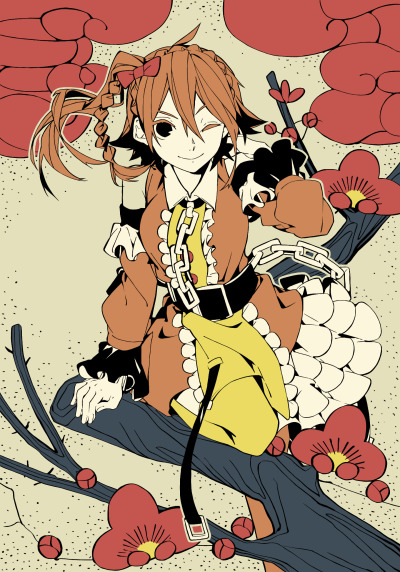
2. February
Kisaragi: changing clothes month
February - Ume 梅 - Plum Blossoms
.... THIS IS LITERALLY HER NAME. (I though like that too when read the meaning)
“February is represented by the ume (plum) blossom, which is the first of the flowers to bloom in the year. The plum blossom and nightingale are frequently shown together to symbolize the coming of spring.”
“Ume Blossoms are often mentioned in Japanese poetry as a symbol of Spring.”
“Japanese tradition holds that the Ume functions as a protective charm against evil.” “The eating of the pickled fruit for breakfast is also supposed to stave off misfortune.“
Indeed, her songs are has some sort of “fight against misfortune” context on them. For herself in Kisaragi Attention and for Hibiya in Otsukimi Recital
“The Japanese Bush Warbler (鶯 Uguisu) - Cettia diphone, is a passerine bird more often heard than seen” “ The Japanese Bush Warbler tends to remain deep in the shadow of foliage during the day.”
It seems, Momo’s job as idol, and the fact that she canonically can sing well, is a reference to nightingale, which is a bird with beautiful voice
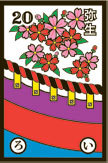

3. March
Yayoi: new life
March - Sakura 桜 - Cherry Blossoms
“March is represented by the sakura (cherry) blossom. Although the plum is the first blossom of the year, the cherry tree marks the real beginning of spring, and new life.”
“The cherry blossom is a symbol of the brevity and uncertainty of life. Youth, pleasure, fame, and misfortune, all blossom and fade like the ephemeral cherry blossom. The cherry blossom is a reminder to focus on the present.” “It is a symbol of the brevity and uncertainty of life “
“Sakura also symbolise clouds due to their nature of blooming en masse. They are an aspect of Japanese cultural tradition that is often associated with Buddhist influence and which is embodied in the concept of 'Mono no aware' (which is a Japanese term for the awareness of the transience of things and a gentle sadness (or wistfulness) at their passing).“
Mary, who has very long live, gradually notice that everything change, and everything will not last forever. In fact, this is one of the main theme in Kagerou Project
“The bright card is called the "camp curtain". This was used as part of a Japanese tradition where people would gather in groups to view blossom on trees (hanami)”
This is not relevant for now, but it has relation with the later card meaning


4. April
Uzuki: deutzia flower month
April - Fuji 藤 - Wisteria
“The name for April, Uzuki, refers to the deutzia flower or unohana, a flowering shrub. This is a popular flower in Japan that signals the beginning of summer.”
“The flower for April is Japanese wisteria (fuji) which blooms at this time of year and is cultivated in Japanese ornamental gardens and arranged into spectacular cascading displays. Once, wisteria was a popular symbol in family crests and heraldry.”
“The cuckoo and wisteria are often shown together as symbols of late spring and the beginning of summer. The cuckoo usually calls in the dark of summer nights. The call of the cuckoo is said to sound like someone calling, “return home.”“
Hibiya and Hiyori’s neverending story is taking place in certain summer. It’s a story of them who can’t return home
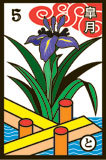

5. May
Satsuki: rice shoot planting month
May - Ayame 菖蒲 - Iris
May is represented by the ayame (iris) blossom. The ayame represents virility and is often displayed on Boys’ Day, May 5th.
The 5-point card depicts the ayame alongside a bridge. This is a reference to a chapter from The Tale of Ise, a collection of poems from the 10th century Japan. The Tale of Ise is a very well known piece of Japanese literature.
The story is about a member of the Imperial Court in Kyoto who was assigned to a new post far to the East. He left his family behind in the Capital as he travelled on his long journey. Along the way, he and his companions lost their way.
They came to a place called yatsuhashi, or “eight bridges.” This was a swampy area where a large river split into eight smaller rivers. Each of the rivers was crossed by a bridge. The whole area was filled with blooming irises.
The court official was feeling rather sad, was lost, and missed his wife. The men stopped to rest, and the court official wrote the following poem:
Karagoromo
kitsutsu narenishi
tsuma shi areba
harubaru kinuru
tabi wo shi zo omou
Translation:
I have a beloved wife
Familiar as the skirt
Of a well-worn robe
And so this distant jouneying
Fills my heart with grief
At first glance, the poem seems to have nothing to do with irises. However, the poem is an acrostic. The first Japanese letters of the Japanese poem spell out “ka-ki-tsu-ba-ta” which is the Japanese name for the species of iris that filled the marshes.

Blue Iris symbolizes “Hope and faith”
I had to put this story, because the story of a traveler who lost his way, missed his loved one and passing through bridge on his journey is maybe.... a reference of this:



6. June
Minazuki: month of water
June - Botan 牡丹 - Peony
The name for the month Mi-na-zuki is an example of ateji. The name Minazuki is made up of three Chinese characters: (water-not-moon). The middle character for “not” was often substituted as the ateji, or phonetic equivalent, for “na” which is the possessive article “of.” So Minazuki can be read as both “the month of water” and “the month without water.”
June is represented by the botan (peony) blossom, a beautiful flower native to China. in China and Japan the peony is a symbol of wealth, good fortune and prosperity. The Peony is known for its medicinal properties and large fragrant flowers. It is often shown with butterflies in Chinese and Japanese paintings. The flowers are full of nectar and attract many insects.
When depicted in visual art and poetry, tree peonies represent good fortune and prosperity, bravery and honour.
Generally, Kido often associate with dogwood flower (because of Never Lost Word). But, in novel route, it’s shown that Kido live in mansion with her rich family pre-incident, so, it’s probably a reference of that.


7. July
Fumizuki: book month
July - Hagi 萩 - Bush Clover
The exact meaning of Fumizuki is somewhat obscure. Some think that in the lazy days of midsummer, between the planting and harvesting seasons, people had time to write and read letters and poetry. Another theory is that the month was originally Fumuzuki which means “swollen month,” referring to the swelling rice grains in the fields
July is represented by the hagi (bush clover) and inoshishi (wild boar)
The strange animal depicted is a young Japanese boar or inoshisi. In Japan, it is widely seen as a fearsome and reckless animal, to the point that several expressions in Japanese referring to recklessness include references to boars. The boar is the last animal of the oriental zodiac, with people born at this time said to embody the boar's traits of determination and impetuosity. Backwoods folk in Japan sometimes name their sons after the animal in tribute to its qualities. Boars are also seen as symbols of fertility and prosperity.
Wild boars are one of the 12 animals of the Chinese zodiac, and are symbols of bravery and affection. However, to villagers in the mountains the boars can be dangerous pests that destroy crops and gardens.
Sometimes the meat of wild boar was called botan (peony). The meat of deer was called momiji (maple leaf) and that of the horses was sakura (cherry blossoms). In this way the pious Buddhists could pretend to eat as vegetarians.
The flora for July is Japanese bush clover, also known as lespedeza or, in Japanese, hagi. It is associated with melancholy and unrequited love


8. August
Hazuki: leaf month
August - Susuki 薄 - Silver Grass
The name for August, Hazuki, refers to the changing seasons and the falling leaves. August features the suzuki (similar to pampas grass). Some players in Hawaii call the card with the harvest moon, “bozu” (slang for bald-headed). Tsukimi, or moon viewing, is the fall counterpart to cherry blossom viewing. Like the first yaku suggests both cherry blossom viewing and moon viewing are often accompanied by the drinking of sake, or rice wine. The traditional date for moon viewing is August 15th.
JIN. Jin, you did not plan the Kagepro plot while playing hanafuda... right?
August is represented by maiden silvergrass, also called eulalia or susuki grass. Traditionally, the grass was used to thatch buildings and for feed for livestock. It is one of "the seven flowers of autumn" (along with bush clover, above)
The card with wild geese shows the seasonal migration of birds. In the fall geese migrate from Siberia and Northern China to spend the winter in Japan.

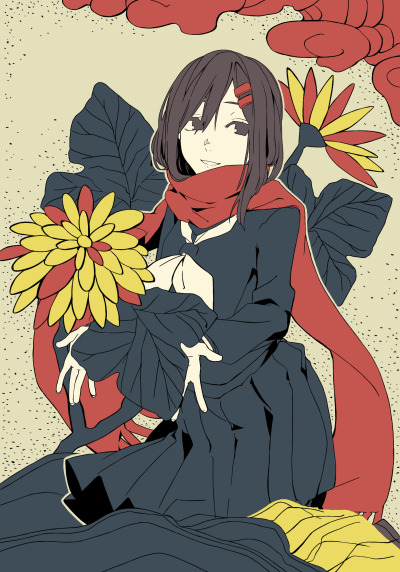
9. September
Nagatsuki: long month
September - Kiku 菊 - Chrysanthemum
Nagatsuki, or long month, marks the beginning of autumn when the nights begin to be longer than the days. September is represented by the kiku (chrysanthemum) blossom.
The large yellow blossoms of the chrysanthemum are a fitting symbol for the radiant sun.
The Chrysanthemum is also a symbol of longevity because of the long life of the blooms. There is a legend of a place in Japan called Chrysanthemum Mountain. It is said that if you drink from the stream where the petals of the chrysanthemum fall into the water you will be blessed with long life. The 5-point card depicts the kiku next to a stream with a sake (rice wine) cup. Inside the wine cup the character for “longevity” is written. It was a common tradition to sprinkle chrysanthemum petals in one's wine and drink them as a way to ensure long life and happiness.
Ah, yeah, Crysanthemum. Where we ever see that?


I think I don’t have to explain more. But it seems, the colour of the crysanthemum in the MVs is supposed to be yellow (?)
Royal crysanthemum has 16 layers petals, which is interesting because Ayano died presumably on 16 years old.
by the way... Additional Memory was released in September
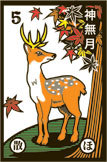

10. October
Kaminazuki: month of the gods
October - Momiji 紅葉 - Maple
In this month, all of the 8 million Shinto gods leave their provincial shrines to congregate at the Great Shrine in Izumo (Izumo Taisha)– the center of Shinto religion
Like the month of June (Mizunazuki), Kaminazuki (October) can be interpreted two ways. It can be read as the “month of gods” or “month without gods.” In this case, both readings can be correct whether you are in Izumo or not.
October features the autumnal colours of falling Japanese maple leaves (momiji or kito). These symbolise calm, rest and peace.
The Stag on the card 'Momiji ni Shika' represents gentleness. Together with the red Maple, they are a symbol of longevity.
This suit is more commonly known as 'Shika' (鹿) (Deer) in Japan.
Seto Kousuke, a gentle person who loves deer.
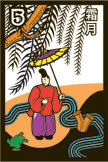

11. November
Shimotsuki: frost month
November - Yanagi 柳 - Willow
November is known as the yanagi (willow), or ame (rain) suit. The willow tree is a symbol of grace and strength. In China and Japan, the willow symbolizes the traits of an ideal woman.
November's suit is a bit strange as it is as much about rain as it is about the plant depicted, which is willow (yanagi – a Japanese word also used for a long, thin-bladed knife thought to resemble one of weeping willow's cascades). The tree is associated with ghosts and spirits.
The tsubame (swallow) is often shown with the willow. They are seen as good companions and are symbols of happiness and harmony.
The other notable figure in the November suit is the man with an umbrella. This man is the famous Heian period calligrapher Ono no Toufuu
The lone junk card for this month is called the lightning card (or gaji in Hawaii where it is most likely to be singled out). In some games, it can be used as a sort of super-card or joker. It is the only card in a hanafuda deck which does not show its month's flower (so players have to explicitly remember which month it comes from). Instead, it depicts a (rather abstract) storm scene with rain, and sometimes a devil's claw, coming down from the sky to beat on a drum. The dark rectangles are possibly the torn camp curtain (see March).
Note that Korean games swap the months of November and December around.
..... Didn’t the accident involving him and Ayaka is when it’s raining? Oh, God...
It’s torn camp curtain from March (The card with Mary). The storm is destroy the place that use to enjoy Sakura...
And the fact some game is swap between November and December is interesting because the December card is...

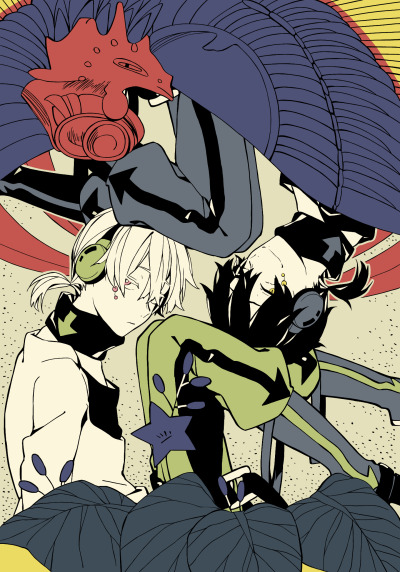
12. December
Shiwasu: priests run
December - Kiri 桐 - Paulownia
This month's symbol is the princess tree (aka paulownia, aka empress tree, aka foxglove-tree) known in Japanese as kiri.
The phoenix card is known in Hawaii as the tori (chicken) card. The phoenix (Hō-ō 鳳凰) is the symbol of righteousness and often connected with the empress. It is a representation of the mandate from heaven giving the Emperor the authority to rule. Legend says that only the kiri tree is beautiful enough for the phoenix to land on.
this mythical bird represents fire, the sun, justice, obedience, and fidelity.
According to Chinese legend, the Hō-ō appears very rarely and only to mark the beginning of a new era. In other traditions, the Hō-ō appears only in peaceful and prosperous times and hides itself when there is trouble. As the herald of a new age, the Hō-ō decends from heaven to earth to do good deeds and then it returns to its celestial abode to await a new era.
It is both a symbol of peace (when the bird appears) and a symbol of disharmony (when the bird disappears).
The Kiri tree beautiful enough to phoenix to land on. As shown in the card, Konoha is on Kiri tree side, while Kuroha (saeru) is on pheonix side. (As like Saeru posessed Konoha (?)
And the fact it means mark the beginning of new era -> mark the beginning of timeline?
By the way, if you ever play this card, you know about the bright cards (The highest value card);




TLDR; Jin write Kagepro while playing this card (wrong conclusion)
I want to update later, so all thoughts are apreciate ^^, tell me if I made mistake tho
(The photos of the merch are from this post by @hollsos)
#kagerou project#kagepro#kagerou daze#mekakucity actors#Ayano tateyama#Kido Tsubomi#Kano Shuuya#Seto Kousuke#Marry Kozakura#Momo Kisaragi#Ene#Shintaro Kisaragi#Hibiya Amamiya#Hiyori Asahina#Konoha#Kuroha#Kenjirou Tateyama#theory#sidu
121 notes
·
View notes